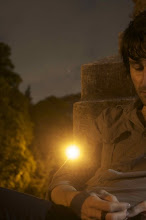One of my favourite writers is Kyle Gann. He's an American composer and writer who specializes in 'downtown', 'postminimal' and 'totalist' musics. I don't always agree with his views - and we've had the occassional verbal stoush on his blog - but I'm always drawn to his down-to-earth and insightful comments.
I was reading his book Downtown Music the other day when I came across a concept he calls 'imaging'. The basic gist is that whereas many pieces of music are impressive because of the way they 'develop' their material, others capture us through 'images' - highly memorable clusters of information that strike us as fully self-contained moments. Think of the opening high bassoon solo in Stravinsky's The Rite Of Spring. The shimmering opening chords of Mendelssohn's Overture to A Midsummer Night's Dream. The giant orchestral swell in A Day In The Life by The Beatles.
Sure, we need to connect these images somehow - that's what Gann calls the 'language' of music - but what makes a piece powerful is when an image is so intense that it continues ringing in our ears long after the piece has ended.
I had a 'eureka!' moment when I read this. I felt like I had finally discovered a way to describe what I've always loved about music. To descibe why most classical music leaves me cold and why I always feel inadequate when comparing my music to the academic standard.
I love images. I love statements. I love titles, one-line poems, phrases, non sequiturs - anything where the intent is present in a single gesture. I find most novels, films and classical pieces pretty tedious because of all the 'back-up' information - the development, the plot, the connecting bits. I'd rather read a book of short stories or essays than a novel. I'd rather watch a series of animations than a film. I'd rather an album full of beautiful short songs than a symphony.
Occassionally I find that the two line up perfectly - Matthew Barney's film "Cremaster 3", for instance. It's been described as a kind of 'moving sculpture' - a whole bunch of seemingly static scenes - however, the way they build incrementally throughout the first part of the film was absolutely sublime. Perhaps that's what I might aspire to in my own work.
Anyway, it gave me courage to continue pursuing 'images' in my work and not to feel so pressured to hide them through the connecting 'language'. In any case I totally suck at musical language, so I guess its all for the best.
By the way, if you want to read Kyle's excellent blog just follow this link:
www.artsjournal.com/postclassic
Just don't forget to come back again!
Sunday, December 09, 2007
Subscribe to:
Post Comments (Atom)


1 comment:
I see the world of blogging is contagious! Awesome!
Post a Comment